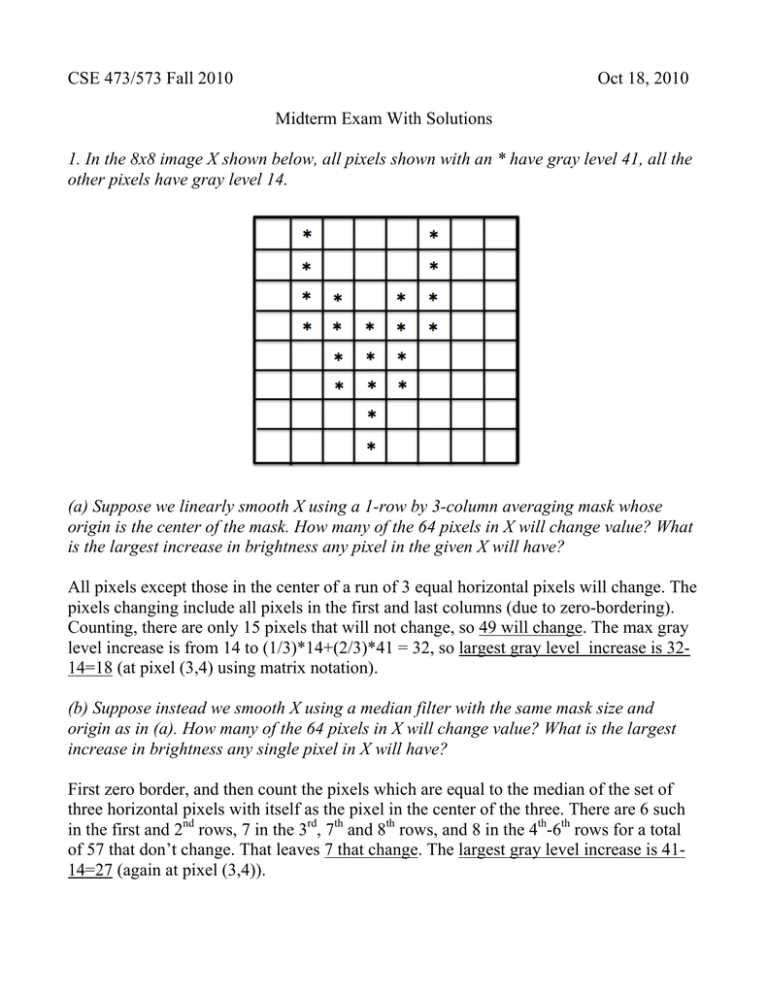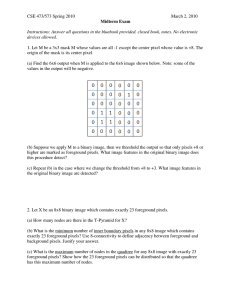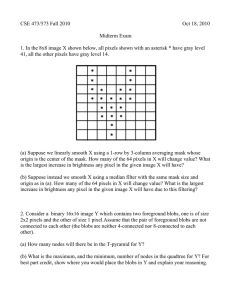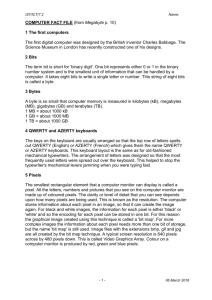Document 10506020
advertisement

CSE 473/573 Fall 2010
Oct 18, 2010
Midterm Exam With Solutions
1. In the 8x8 image X shown below, all pixels shown with an * have gray level 41, all the
other pixels have gray level 14.
(a) Suppose we linearly smooth X using a 1-row by 3-column averaging mask whose
origin is the center of the mask. How many of the 64 pixels in X will change value? What
is the largest increase in brightness any pixel in the given X will have?
All pixels except those in the center of a run of 3 equal horizontal pixels will change. The
pixels changing include all pixels in the first and last columns (due to zero-bordering).
Counting, there are only 15 pixels that will not change, so 49 will change. The max gray
level increase is from 14 to (1/3)*14+(2/3)*41 = 32, so largest gray level increase is 3214=18 (at pixel (3,4) using matrix notation).
(b) Suppose instead we smooth X using a median filter with the same mask size and
origin as in (a). How many of the 64 pixels in X will change value? What is the largest
increase in brightness any single pixel in X will have?
First zero border, and then count the pixels which are equal to the median of the set of
three horizontal pixels with itself as the pixel in the center of the three. There are 6 such
in the first and 2nd rows, 7 in the 3rd, 7th and 8th rows, and 8 in the 4th-6th rows for a total
of 57 that don’t change. That leaves 7 that change. The largest gray level increase is 4114=27 (again at pixel (3,4)).
2. Consider a binary 16x16 image Y which contains two foreground blobs, one is of size
2x2=4 pixels and the other of size 1 pixel. Assume that this pair of foreground blobs are
not connected to each other (the blobs are neither 4-connected nor 8-connected to each
other).
(a) How many nodes will there be in the T-pyramid for Y?
16x16+8x8+4x4+2.2+1x1=341 nodes
(b) What is the maximum, and the minimum, number of nodes in the quadtree for Y? For
best part credit, show where you would place the blobs in Y and explain your reasoning.
Maximum: set the 2x2 in the center of Y, forcing 4 paths in the quadtree to descend down
to the pixel (16x16) level. Then set the 1x1 on any corner of any of the major quadrants.
Get 13 nodes each quadrant due to the 2x2 (nodes in red below) plus 8 more due to the
1x1 (red nodes at 8x8 and 16x16 levels), plus the root node, for total of 4*(13)+8+1=61
nodes max.
Minimum: set the 2x2 in a corner of any quadrant with the 1x1 one pixel separated from
it by one pixel in the same quadrant. Then the quadtree contains one path to the 16x16
level (red nodes above), paths to the three other 2x2 nodes, and the root node, a total of
17 nodes min.
3. (a) Y is a binary image with foreground pixels shown in black. Find the erosion of Y by
the stucturing element B1={(1,0),(0,1),(1,1)}. Give your answer graphically, with
foreground pixels shown in black and the origin marked as above.
(b) Find the structuring element B2 so that Y above is the dilation of the binary image X
below. Give your answer graphically, with foreground pixels shown in black and the
origin marked.
First note that (4,5) is in X but not Y, so the origin is not a foreground pixel in B. Now put
the origin of B at (4,5). B must be some subset of the 7 black pixels in the first two rows
of Y. But the left 2 can’t be in B, else when we moved the origin to the pixel at (3,5) we
would get additional pixels in Y. Also the pixel above (4,5) and the two to its left must be
in B, else these pixels would not appear in Y. So far, it seems there are two possible B’s:
But when the origin of B is put on some of the other pixels, for instance (4,0), we see the
one on the left is the solution, the other does not work. For instance, using the one on the
right, (3,1) in Y should be black but it is not.






